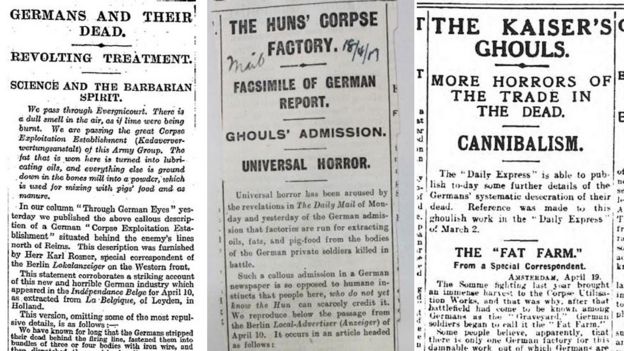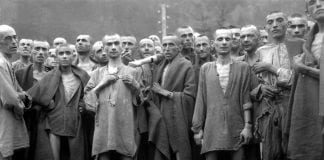Think fake news is a new phenomenon? Think again. Dr David Clarke from Sheffield Hallam University looks at a 100-year-old story that fooled the world.
Fake news, false stories that masquerade as real news are not new.
In the spring of 1917 some of Britain’s most influential newspapers published a gruesome story that has been called “the master hoax” – and I think we finally have proof about where it came from.
Britain was at the time trying to bring China into the war on the Allied side.
In February a story appeared in the English-language North China Daily News that claimed the Kaiser’s forces were “extracting glycerine out of dead soldiers”.
Rumours about processing dead bodies had been in circulation since 1915 but had not been presented as facts by any official source.
‘Smell of burnt limes’
That changed in April when the Times and the Daily Mail published accounts from anonymous sources who claimed to have visited the Kadaververwertungsanstalt, or corpse-utilisation factory.
The Times ran the story under the headline Germans and their Dead, attributing the claim to two sources – a Belgian newspaper published in England and a story that originally appeared in a German newspaper, Berliner Lokal-Anzeiger on 10 April.
That German account by reporter Kal Rosner described an unpleasant smell “as if lime was being burnt” as he passed the corpse factory.
Rosner used the word “kadaver”, which referred to the bodies of animals – horses and mules – not human bodies.
Later, The Times carried a longer article quoting from an unnamed Belgian source who described in grim detail how the corpses were processed.

A cartoon published soon afterwards by Punch presented the ghoulish story with the caption “cannon fodder – and after”.
The German government protested loudly against these “loathsome and ridiculous” claims.
But their protests were drowned out by public expressions of horror from the Chinese ambassador. China declared war against Germany on 14 August 1917.
However, until now no one has been able to discover conclusive proof that would settle the mystery of who created the story – and who authorised its transformation from a false rumour to officially-sanctioned “fact”. I believe we now can.
‘Captions swapped’
It was in 1925 that Sir Austen Chamberlain admitted, in a Commons statement, there was “never any foundation” for what he called “this false report”.
In the same year the Conservative MP John Charteris – who served as head of intelligence – reportedly admitted, while on a lecture tour of the US, that he had fabricated the story.
The New York Times revealed how Charteris said he had transposed captions from one of two photographs found on captured German soldiers.
One showed a train taking dead horses to be rendered, the other showed a train taking dead soldiers for burial.
The photo of the horses had the word “cadaver” written upon it and Charteris reportedly said he “had the caption transposed to the picture showing the German dead, and had the photograph sent to a Chinese newspaper in Shanghai”.
On his return to Britain, Charteris denied making the remarks. Since that time, no one has been able to discover the photographs or any clear documentary evidence that would prove the intelligence services connived with the press to promote the corpse factory lie.

But I have found what I believe to be one of the photographs mentioned by Charteris in a collection of Foreign Office files at The National Archives.
The black and white image, dated 17 September 1917, clearly shows bodies of German soldiers, tied in bundles, resting on a train behind the front line just as Charteris had described in 1925.
The covering letter, from a military intelligence officer at Whitehall, is addressed to the government’s Director of Information, Lt Col John Buchan, author of The 39 Steps.
The letter from MI7, the military’s propaganda unit, offers the War Office “a photograph of Kadavers, forwarded by General Charteris for propaganda purposes”.
https://albertjack.com/2021/06/25/spot-fake-news-story/
Lies have consequences
In 1917 MI7 employed 13 officers and 25 paid writers, some whom moonlighted as “special correspondents” for national newspapers.
One of their most talented agents was Major Hugh Pollard who combined his work in the propaganda department with the role of special correspondent for the Daily Express.
After the war Pollard confessed his role in spreading the corpse factory lie to his cousin, Ivor Montague.
Writing in 1970, Montague recalled “we laughed at his cleverness when he told us how his department had launched the account of the German corpse factories and of how the Hun was using the myriads of trench-war casualties for making soap and margarine.”
But lies have consequences. During the 1930s the corpse factory lie was used by the Nazis as proof of British lies during the Great War.
Historians Joachim Neander and Randal Marlin remind us how these false stories “encouraged later disbelief when early reports circulated about the Holocaust under Hitler”.
–
You can follow Albert on Twitter and Instagram
Or join the free mailing list (top right) and please comment on story below






































